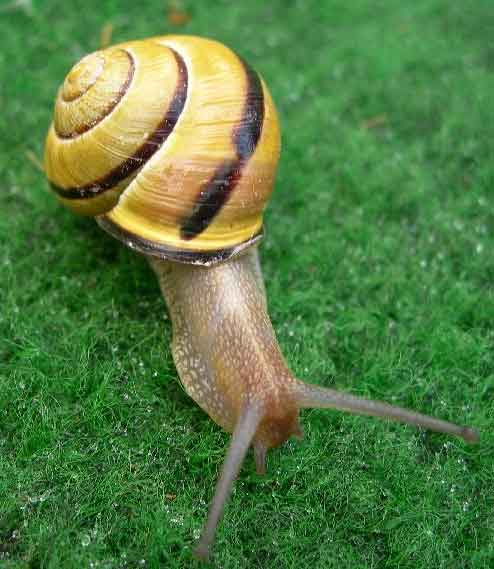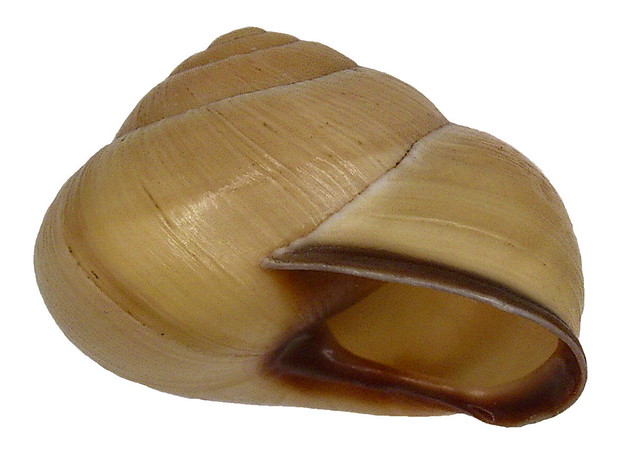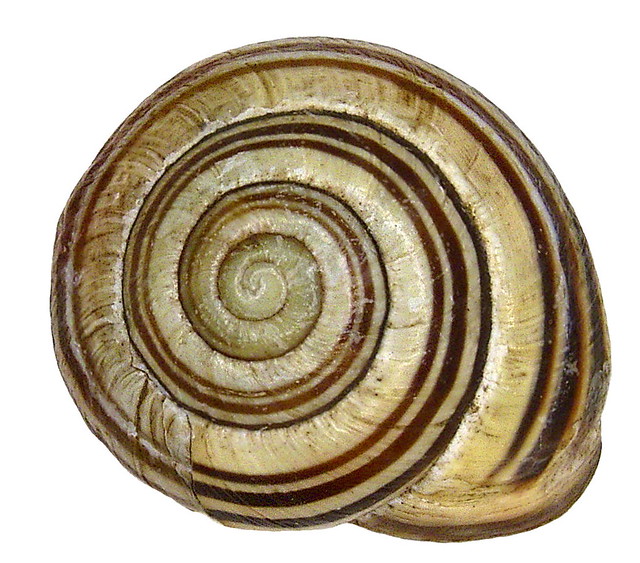Cepaea nemoralis (*) Cladus: Eukaryota Cepaea nemoralis Cepaea nemoralis --------- The grove snail or brown-lipped snail (Cepaea nemoralis) is a species of air-breathing land snail, a terrestrial pulmonate gastropod mollusk. It is one of the most common species of land snail in Europe and has been introduced to North America. Description This is a relatively small snail: the shell can reach a height of about 20 mm and a width of 25 mm. The surface of the shell is semi-glossy, and it has from 4½ to 5½ whorls. C. nemoralis is closely related to the white-lipped snail, Cepaea hortensis, and shares much the same habitat. The grove snail is usually the larger of the two species when mature, but the principal difference is that the adult grove snail almost always has a dark brown lip to its shell, whilst adults of Cepaea hortensis almost always have a white lip. However, this distinguishing feature is not entirely reliable, as there is at least one morph of the grove snail which also has a white lip. When the identity of an adult individual is questionable, and it is necessary to distinguish the two species, a dissection can be used in order to examine the anatomy: the structure of the love dart is quite different in the two species, as are the vaginal mucus glands. The size of the egg is 3.1 × 2.6 mm.[2] Coloration Apart from the band at the lip of the shell, grove snails are highly polymorphic in their shell colour and banding. The background colour of the shell can sometimes be so pale as to be almost white; it can also be yellow, pink, chestnut through to dark brown, and the shells can be with or without dark bandings. The bands vary in intensity of colour, in width and in total number, from zero up to a total of six. These polymorphisms have been highly studied as part research in heredity and evolution. They are thought to act as camouflage to avoid predation from, for example, the Song Thrush, but also have implications for the body heat of the animal: darker shells heat up more quickly, with consequences for rates of metabolism and loss of moisture (crucial in snail locomotion). In particular, grove snails with dark brown appear to preferentially be found in dark woodlands, whilst snails with light yellow shells and thin banding are more commonly found in grassland. Gallery Different coloration and banding of the shells of Cepaea nemoralis The grove snail can be found in a range of habitats: most commonly in grassland, hedgerows and woodland. Its native distribution is from northern and western Europe to central Europe (the Czech Republic[3] and others). In eastern Europe it occurs in urban areas. More recently, the grove snail has been introduced to North America, and has established itself in various places. The white-lipped snail has a similar range, but that species extends further north to border the Arctic. Conservation status * Not listed in IUCN red list - not evaluated (NE)[4]
1. ^ Linnaeus C. 1758. Systema naturae per regna tria naturæ, secundum classes, ordines, genera, species, cum characteribus, differentiis, synonymis, locis. Tomus I. Editio decima, reformata. pp. [1-4], 1-824. Holmiae. (Salvius). Source: Wikispecies, Wikipedia: All text is available under the terms of the GNU Free Documentation License |
|



